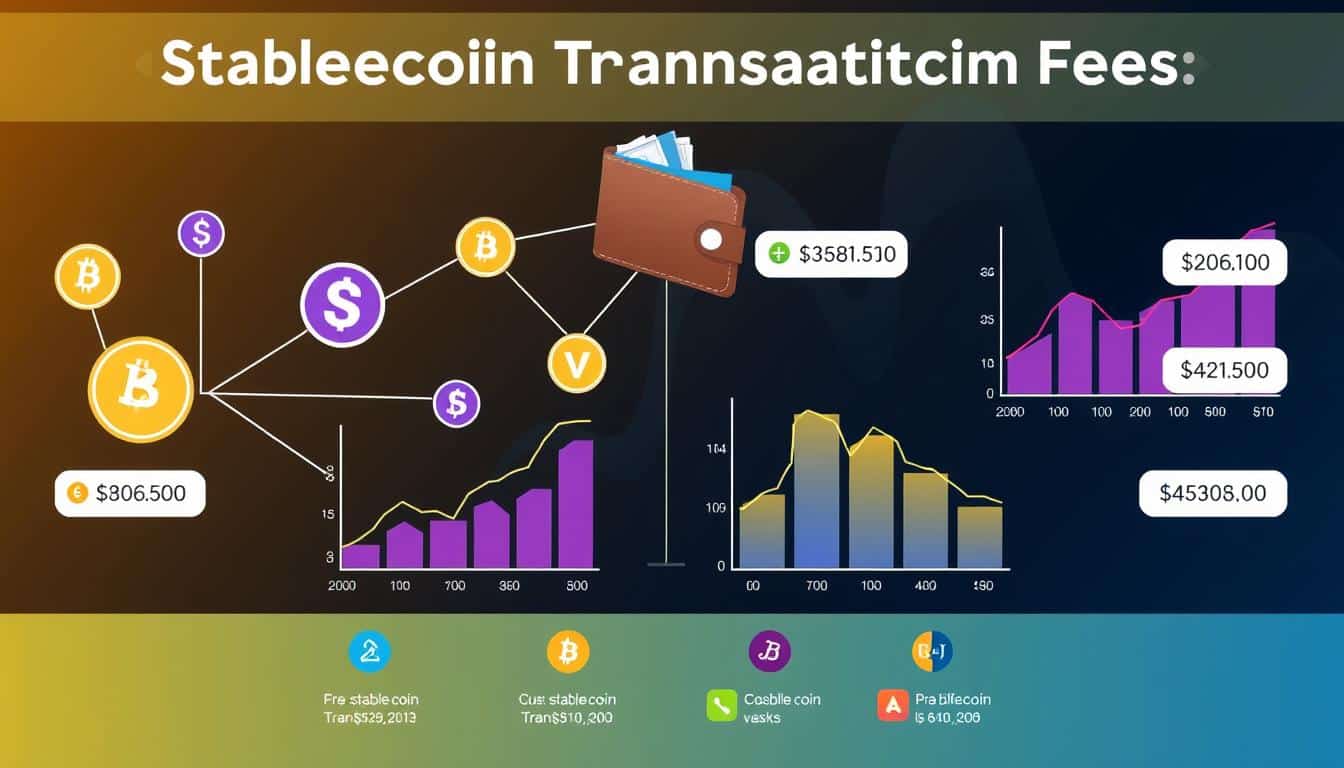Understand Stablecoin Transaction Fees: A Comprehensive Guide

Digital asset transfers can slash costs by up to 80% compared to traditional banking fees. Stablecoin transaction fees are revolutionizing financial transactions in the crypto world1. As the crypto market grows, grasping these fees becomes vital for investors and users2.
Cryptocurrency fees have changed how we view money transfers. Stablecoins offer predictable costs and stable value in the volatile digital currency world. These digital assets bridge traditional finance and blockchain technology3.
Stablecoin transaction fees are complex yet intriguing. Network dynamics and regulations influence how these fees are calculated. Investors and users must navigate this system carefully.
Key Takeaways
- Stablecoin transaction fees offer significant cost savings compared to traditional banking
- Digital asset transfer costs vary based on network conditions and blockchain technology
- Understanding fee structures is crucial for effective cryptocurrency management
- Stablecoins provide a more predictable financial transaction method
- Technology continues to drive down cryptocurrency fees
What Are Stablecoin Transaction Fees?
Stablecoins are unique digital assets in the blockchain world. They provide price stability amid cryptocurrency volatility. These digital currencies connect traditional finance with decentralized platforms, offering reliable blockchain payment management.
Understanding Stablecoins
A stablecoin is a cryptocurrency designed to keep a steady value. It’s usually pegged to a stable asset like the US dollar. Unlike traditional cryptocurrencies, stablecoins aim to minimize price fluctuations.
They play a key role in managing DeFi transaction costs. Stablecoins provide a predictable way to exchange value on these platforms.
Importance of Transaction Fees
Transaction fees are vital for blockchain networks. They serve several important functions:
- Maintaining network security
- Incentivizing blockchain validators
- Preventing spam transactions
- Supporting network infrastructure
Differentiating from Traditional Fees
Stablecoin transaction fees are different from regular banking charges. They offer unique benefits:
| Feature | Stablecoin Fees | Traditional Banking Fees |
|---|---|---|
| Transaction Speed | Near-instantaneous | 1-3 business days |
| Cross-Border Costs | Low | High |
| Fee Transparency | Fully transparent | Often hidden |
“Stablecoins represent the future of efficient, transparent financial transactions in the digital age.”
Chainlink’s network has processed an impressive amount of transaction value. Over $18 trillion has flowed through its infrastructure4.
This shows how important stablecoins are becoming. They manage blockchain payment charges and make digital transactions smoother.
Types of Stablecoins and Their Fees
Stablecoins offer various ways to keep their value steady while managing transaction costs. The crypto world has different types of stablecoins, each with unique features.
Fiat-Collateralized Stablecoins
These stablecoins are backed by traditional currency reserves. They provide a simple way to make digital transactions. Market research shows their fees usually range from 0.10% to 0.50% of the transaction amount5.
- Low volatility compared to other cryptocurrencies
- Direct connection to traditional financial systems
- Predictable stablecoin network fees
Crypto-Collateralized Stablecoins
These digital assets use cryptocurrency as collateral. Their fee structure is more dynamic. Transaction costs can change based on blockchain performance5.
| Characteristic | Impact on Fees |
|---|---|
| Network Congestion | Increases transaction fees |
| Market Demand | Influences pricing mechanisms |
| Blockchain Type | Determines base transaction cost |
Algorithmic Stablecoins
This type uses smart contracts to keep prices stable. Market conditions can greatly affect their transfer pricing. These stablecoins are the most complex5.
Some stablecoins charge no fees for transactions within their network, promoting near-instant and cost-effective transfers5.
Users must carefully choose their stablecoin options. Transaction fees can greatly impact financial efficiency. It’s important to consider all factors before making a decision5.
Factors Influencing Stablecoin Transaction Fees
Stablecoin transaction costs vary based on several key factors. Understanding these elements helps users navigate the complex world of on-chain fee structures. Let’s explore the main influences on decentralized finance fees.
Network Congestion and Its Impact
Network congestion significantly affects transaction fees. High traffic periods on blockchain networks drive up gas fees. Popular networks like Ethereum experience dramatic fee changes based on demand6.
- High traffic periods increase transaction costs
- Blockchain scalability directly influences fee structures
- Time of day can significantly affect transaction expenses
Transaction Size Dynamics
Transaction size plays a crucial role in fee determination. Larger transactions require more computational resources, resulting in higher fees. Users can optimize costs by understanding data volume impacts7.
| Transaction Size | Estimated Fee | Network Impact |
|---|---|---|
| Small Transactions | Low | Minimal Network Load |
| Medium Transactions | Moderate | Average Network Load |
| Large Transactions | High | Significant Network Load |
Wallet Selection Matters
The choice of wallet can dramatically influence transaction fees. Some wallets offer advanced fee optimization features. Crypto platforms are focusing on providing cost-effective solutions for digital asset management6.
Smart wallet selection can lead to significant long-term savings in transaction costs.
Understanding these factors helps users make informed decisions about stablecoin transactions. This knowledge can lead to reduced costs and improved financial strategies. Smart choices in timing, size, and wallet selection can make a big difference.
Comparing Stablecoin Transaction Fees to Other Cryptocurrencies
Digital currency remittance costs vary across different cryptocurrencies. Understanding these differences is key for investors and users. Blockchain payment charges can significantly impact financial strategies.
Stablecoins offer a compelling alternative to traditional cryptocurrency fee models. They provide unique advantages in terms of cost and stability.
Bitcoin Transaction Fees: A Costly Landscape
Bitcoin fees can be unpredictable and expensive. During network congestion, costs can skyrocket. This makes smaller transactions less feasible.
- Highly variable fee structures
- Potential for significant cost spikes during busy periods
- Complex fee calculation methods
Ethereum’s Fee Challenge
Ethereum has faced high transaction costs. This is especially true during busy network periods. Digital currency remittance costs can be substantial for decentralized finance (DeFi) applications.
Stablecoins: A Cost-Effective Solution
Stablecoins offer more predictable blockchain payment charges. They use efficient networks or Layer 2 solutions. This approach provides several benefits.
- Lower and more consistent transaction fees
- Faster transaction processing
- Reduced volatility compared to other cryptocurrencies
“Stablecoins represent a more economical approach to digital transactions, bridging the gap between traditional finance and cryptocurrency efficiency.”
Stablecoins offer effective cost management for digital transactions. This makes them attractive for both individuals and businesses.
Their reliability and efficiency make stablecoins a strong choice for digital currency solutions829.
The Impact of Stablecoin Transaction Fees on Users
Stablecoin transaction fees are changing how we transfer digital assets. They affect individuals and businesses differently. Understanding these impacts can help in making smarter financial choices6.
Cost Efficiency for Businesses
Businesses are finding big benefits in stablecoin fees. Small and medium companies can cut cross-border costs significantly. They do this by using digital asset transfer platforms10.
- Lower international payment processing costs
- Streamlined supply chain financial management
- Reduced currency conversion expenses
Benefits for Retail Users
Individual users are seeing new financial opportunities with stablecoins. These digital assets offer more predictable transactions. This allows for better planning of personal finances6.
Digital assets are reshaping personal financial strategies with unprecedented transparency and efficiency.
Long-Term Financial Planning
Cryptocurrency fees are now key in strategic money management. Investors are finding new ways to grow wealth. They’re using blockchain-driven financial services to do this6.
- Implement dollar-cost averaging strategies
- Explore medium to long-term investment options
- Leverage emerging blockchain financial tools
The future of digital asset management promises increased accessibility and reduced transaction costs for all users10.
Popular Stablecoins and Their Fee Structures
Stablecoin network fees vary across different digital assets. It’s important for investors to compare options carefully. Understanding these fees helps users make smart choices for their crypto transfers.
Tether (USDT): The Market Leader
Tether is the top stablecoin in the crypto world. Its fees change based on the blockchain used. Users can save money by picking the cheapest blockchain for their transactions4.
- Most widely used stablecoin globally
- Supports multiple blockchain networks
- Flexible crypto transfer pricing options
USD Coin (USDC): Competitive and Transparent
USD Coin offers low fees, especially in DeFi apps. Its clear fee structure makes it popular. Users can easily predict their transaction costs11.
“USDC provides a reliable and cost-effective stablecoin solution for digital transactions.”
DAI: Decentralization with Unique Fee Dynamics
DAI runs on the Ethereum blockchain. Its fees change based on Ethereum’s network traffic. During busy times, DAI transactions might cost more.
| Stablecoin | Average Transaction Fee | Network Support |
|---|---|---|
| Tether (USDT) | $0.50 – $2.00 | Multiple Blockchains |
| USD Coin (USDC) | $0.25 – $1.50 | Ethereum, Solana |
| DAI | $1.00 – $3.00 | Ethereum |
Knowing these fee structures helps users make smart crypto choices. They can balance costs with network reliability. This knowledge leads to better decisions for cryptocurrency transactions11.
Methods to Reduce Stablecoin Transaction Fees
Stablecoin users can cut costs by using smart strategies. There are several ways to lower transaction fees in decentralized finance. Let’s explore some effective methods12.
Leveraging Layer 2 Solutions
Layer 2 solutions offer a powerful way to cut transaction fees. These platforms work on top of existing blockchains, creating faster transaction paths. Users can save money by using these secondary networks for their decentralized finance transactions12.
- Minimize network congestion
- Reduce overall transaction costs
- Improve transaction speed
Selecting the Right Wallet
Choosing the right wallet is key to managing fees. Smart wallet choices often include built-in tools to optimize fees. This feature helps users spend less on transactions12.
Strategic Transaction Timing
Timing can greatly impact stablecoin transaction fees. Users can lower costs by planning their moves carefully.
- Monitoring network congestion levels
- Executing transactions during low-traffic periods
- Using fee estimation tools
Reducing transaction fees isn’t just about saving money—it’s about maximizing the efficiency of your digital asset management.
Smart strategies can significantly cut decentralized finance fees. This approach improves the overall transaction experience for crypto users12138.
Regulatory Considerations Affecting Fees
Stablecoin fees are shaped by complex global regulations. Governments are creating rules that impact blockchain payment costs. These changes affect the economics of digital currencies.
The stablecoin regulatory landscape poses challenges for investors and financial institutions. Different countries have unique approaches to digital currency rules. This creates a diverse and sometimes unpredictable environment.
Government Regulations on Stablecoins
Regulatory bodies are focusing on comprehensive stablecoin guidelines. Key areas include compliance frameworks and consumer protection. They also aim to prevent financial risks and ensure transparent remittance costs.
- Establishing clear compliance frameworks
- Protecting consumer interests
- Preventing potential financial risks
- Ensuring transparent digital currency remittance costs
Compliance Costs
Stablecoin issuers face high costs to meet regulatory requirements. These compliance costs often translate into blockchain payment charges that impact end-users. Tether leads the industry with a 65% market share14.
Fee Structures in Different Jurisdictions
Global markets have varied regulatory approaches, affecting digital currency costs. The stablecoin market is worth about $212 billion. This represents roughly 6% of the total cryptocurrency market14.
“Regulatory complexity doesn’t deter innovation—it challenges us to be more strategic.” – Cryptocurrency Expert
Financial institutions must analyze blockchain charges and regulations carefully. This helps them develop effective stablecoin strategies. Each jurisdiction offers unique challenges and opportunities for digital transactions.
Future Trends in Stablecoin Transaction Fees
The digital asset landscape is evolving rapidly. It offers exciting opportunities for cryptocurrency fees and transfer costs. New technologies are changing how we interact with stablecoin transactions.
The blockchain ecosystem is transforming stablecoin fee structures. SUI crypto shows impressive growth. Its decentralized exchange volume hit $40 billion, while its stablecoin market cap grew 30% to $420 million15.
Expected Changes in Fee Structures
Emerging trends point to several developments in cryptocurrency fees:
- Decreasing transaction costs through advanced blockchain technologies
- More competitive digital asset transfer costs
- Enhanced scalability reducing overall fee burdens
Innovations in Stablecoin Technology
Tech advances are driving big changes. SUI’s platform has surpassed 8 billion transactions15. It offers 52% higher yields than traditional blockchain networks15.
This signals a potential shift in digital asset management. Users may see more efficient and cost-effective transactions soon.
The Role of Decentralized Finance (DeFi)
DeFi is changing stablecoin transactions. Lending protocols now offer attractive yields. Platforms like NAV and SuiLend provide APYs around 13.63% for USDC15.
These changes suggest a future with more competitive and user-friendly digital asset transfers. Fees may become more affordable and transparent.
The future of stablecoins lies in continuous innovation and user-centric fee structures.
As blockchain tech improves, users can expect better cryptocurrency fees. These fees will likely be more transparent, efficient, and cost-effective13.
How to Make Informed Decisions about Fees
Stablecoin network fees demand strategic thinking and careful research. Users need a smart approach to grasp crypto transfer pricing. This knowledge helps in making wise financial choices.
Several key strategies can help minimize expenses when exploring stablecoin transaction costs. These methods also boost efficiency in your crypto dealings.
- Research different stablecoin platforms thoroughly
- Compare network fees across multiple exchanges
- Utilize specialized fee comparison tools
- Track transaction costs in real-time
Researching Different Stablecoins
Stablecoins vary in their features and benefits. Coinbase, with over 8 million users, offers clear fee structures2.
Binance boasts 200 million global registered users. It provides competitive crypto transfer pricing options2.
Understanding Fee Structures
Comprehensive fee analysis involves examining multiple components:
- Base transaction fees
- Network congestion surcharges
- Exchange platform fees
- Wallet transfer costs
Utilizing Fee Comparison Tools
“Knowledge of fees is the first step toward optimizing your crypto financial strategy.”
Modern crypto platforms offer tools to track and compare stablecoin network fees. These resources help investors make smarter decisions about digital asset transactions.
Grasping crypto transfer pricing requires ongoing learning. Stay adaptable to changes in the fast-paced digital finance world.
Real-World Examples of Stablecoin Fees
Stablecoins have revolutionized digital transactions with unique on-chain fee structures. These digital assets challenge traditional financial systems with their decentralized finance fees. Their practical applications offer compelling insights into modern financial operations.
Real-world scenarios show the huge impact of stablecoin transaction costs across industries. Many businesses now use these digital currencies to streamline their financial processes. This shift is changing how companies handle money matters.
Analyzing Transaction Fee Reports
Recent data proves stablecoins are cost-effective for financial transactions. Ripple’s RLUSD stablecoin has gained popularity, with major exchanges already using the platform16. Its market cap has hit $72 million, showing its growing importance in decentralized finance17.
| Stablecoin | Market Cap | Transaction Fee Range |
|---|---|---|
| RLUSD | $72 million | $0.10 – $0.50 |
| USDC | $24 billion | $0.20 – $0.75 |
| DAI | $5 billion | $0.15 – $0.60 |
Case Studies of Businesses Using Stablecoins
Companies are saving big through stablecoin transactions. They enjoy lower cross-border payment costs and faster processing. Overall transaction fees are also much lower with these digital currencies.
- Reduced cross-border payment costs
- Faster transaction processing
- Lower overall transaction fees
Ripple and Chainlink’s teamwork shows how stablecoins improve financial systems. They use decentralized price feeds to ensure transparent and reliable transactions17. This partnership highlights the growing trust in stablecoin technology.
Stablecoins represent a pivotal shift in digital financial transactions, offering unprecedented efficiency and cost-effectiveness.
Conclusion: The Importance of Knowing Stablecoin Transaction Fees
Understanding cryptocurrency fees is crucial for efficient digital transactions. These costs impact financial performance in the evolving digital economy. Investors must view stablecoin fees as strategic considerations, not just expenses2.
The cryptocurrency fee landscape requires careful analysis and management. Blockchain technologies are changing how we view financial transfers. Stablecoins often offer lower-cost alternatives to traditional banking systems18.
Grasping these fee structures helps users optimize their digital asset strategies. It also allows them to minimize unnecessary expenses. This knowledge is key to making smart financial decisions.
Key Takeaways
Staying informed about digital finance trends is crucial. Users must adapt as regulations change and new technologies emerge. Researching platforms and comparing fees empowers individuals to make cost-effective choices19.
Understanding network dynamics is also important. This knowledge helps users navigate the complex world of cryptocurrency transactions. It enables them to make informed decisions about their digital assets.
Moving Forward
The future of digital asset transfer costs looks bright. Blockchain efficiency is improving, leading to reduced transaction expenses. Users can leverage stablecoins to minimize fees and boost financial potential.
Staying updated on market developments is key. A proactive approach to learning helps users make the most of cryptocurrency opportunities. This knowledge can lead to smarter financial decisions in the digital age.

